Set up Viva Glint User Roles
Admins can assign multiple roles with specific permissions - access to different segments of data and filters - within User Roles. The User Roles and Access template includes prepopulated example roles and detailed instructions for two areas of setup. Use it to plan your Glint programs.
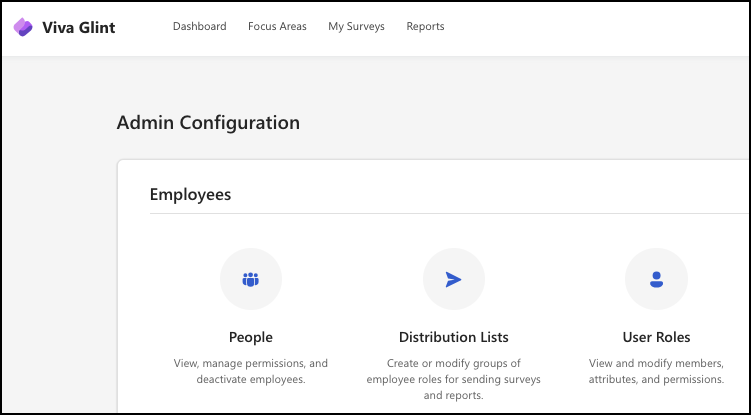
Tip
To protect confidentiality, give managers access to only one filterable attribute. Assigning more than one filterable attribute can increase the chance that a manager is able to deduce the origin of individual responses.
Download this template to use as a planning tool to define permissions for User Roles
Use the template as a planning tool to define permissions for roles, according to these three filter distinctions:
- Report filters: Attributes this role can use to filter results
- Report sections: Attributes this role can use to add sections in reports
- Comment filters: Attributes this role can use as filters in the Comments Report
Important
Not all User Roles and prepopulated attributes and permissions in our template apply to your organization. Use your Employee Attribute File for attributes specific to your organization to customize your template.
Default User Roles
The following roles are pre-configured in Viva Glint and can't be edited. Create a new User Role to edit attributes and permissions.
- Company Admin: Employees who are granted ALL permission; can't be edited
- Advanced Configuration Access
- Active Employees: Not intended to have data access
- Inactive Employees: Not intended to have data access
- Managers: Doesn't allow edits, create a new role to change permissions and attributes
- Support Users: External users, like Partners or Glint Support, who have advanced access; can't be edited
Enable User Roles
Admins can specify the employee population and attributes their leaders can view on their dashboard for each User Role. Defining roles is important for data cuts, access permissions, and program integrity.
Select the Configuration symbol.
In the Employees section, select User Roles.
Select +New Role. The nRole Settings page displays.
Enter a role name in the Untitled Role field by selecting the pencil symbol.

Select Permissions and the Permissions and Access page opens.
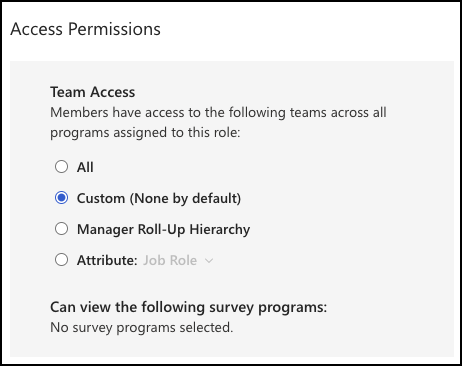
Make choices for these sections based on decisions in your User Role template:
Survey Programs
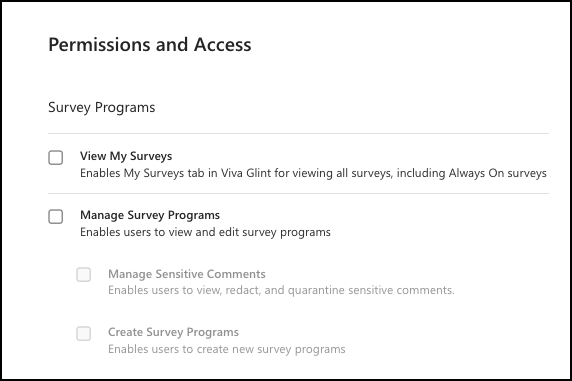
Focus Areas and Conversations
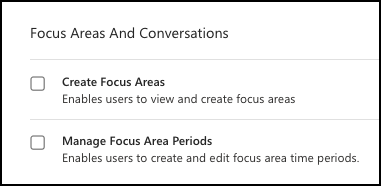
Reporting
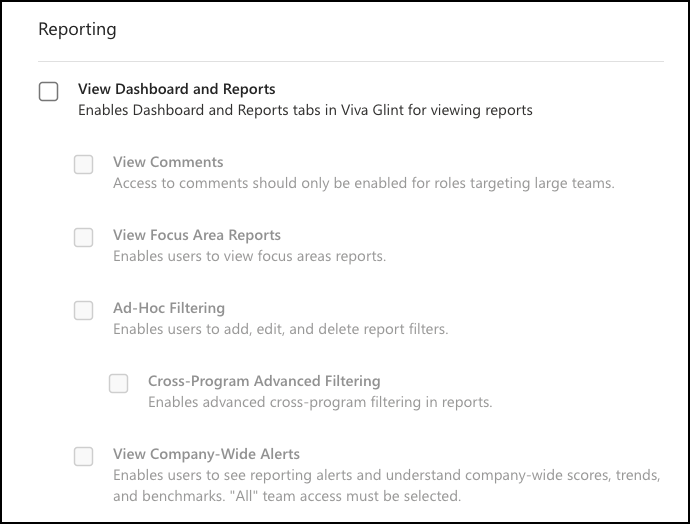
Data Management

Resources
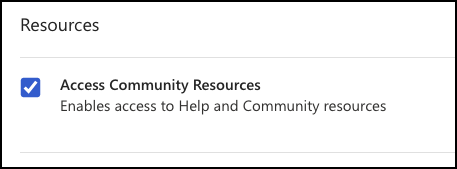
Access Permissions
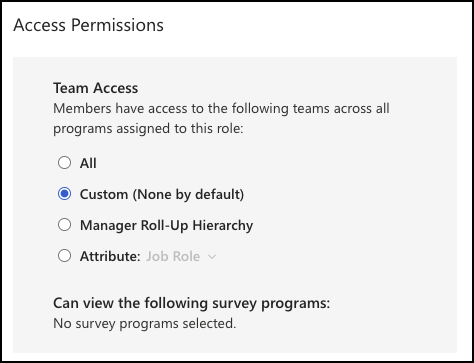
Select Save Changes.
On the Role Settings page, select Report Attributes.

Attributes are separated into sections:
- Standard
- Manager Hierarchy (select all levels, for roles with Manager Hierarchy-based access, users see only their team)
- Other Reporting Hierarchies (like Location or Department Hierarchy)
Select all attributes and hierarchies that this role should be allowed to view for:
- Report filters
- Report sections
- Comment filters
Select Save Changes.
Tip
Filtering through results across too many attributes can make identifying survey respondents easier. For this reason, it's best to give access to only one attribute per manager role.
Add or edit employees in a role
Select the Add/Edit Employees button. The Choose a way to add employees dialog box opens.
Add members to a User Role by choosing from these options:
- Attribute Rules - User rules like location or department to populate a User Role. This dynamically changes with your employee data uploads.
- Import - Use a CSV or XLSX file to import employees for this User Role. This removes attribute rules from this User Role.
Tip
Switching from Attribute Rules to Import removes attribute rules. Switching from Import to Attribute Rules overrides any employees uploaded.
Attribute rule-based User Roles
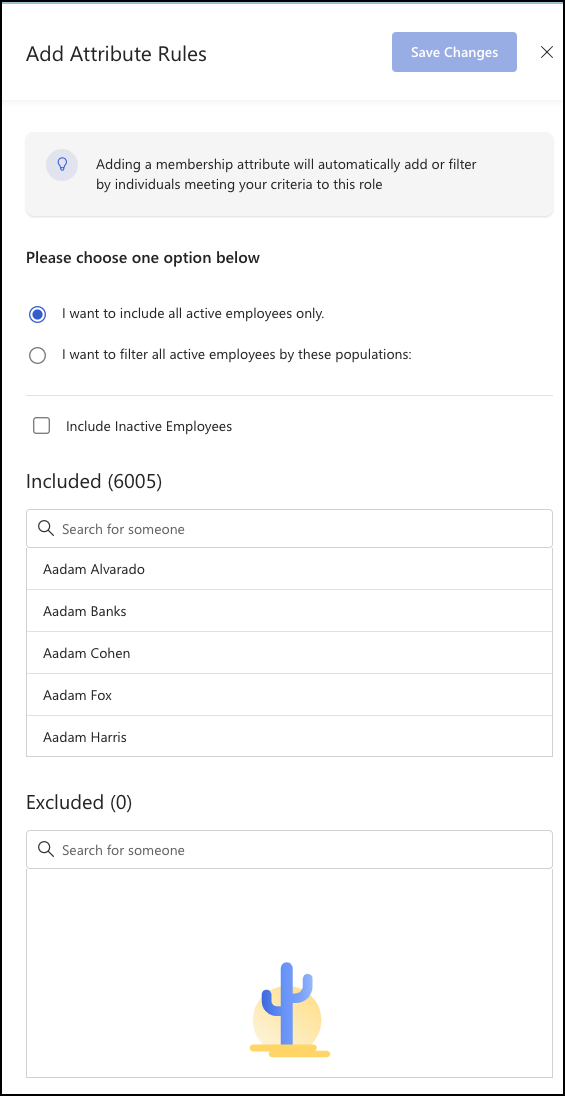
Select User Roles from the Configure section of your admin dashboard.
Choose any role - excluding preconfigured roles.
Select Add/Edit Employees.
In the new display window, choose either:
- I want to include all active employees only, or
- I want to filter all active employees by the following populations
To add users based on a filtered population, select I want to filter all active employees by the following populations.
Select + New Population.
Select + Add Filter to select an attribute to filter your employee list. Your attribute list is unique to your organization based on your Employee Attribute File.
Select Done.
To exclude someone, search their name and select Exclude.
To remove someone from the Excluded list, search their name and select Remove.
Confirm list for User Role and select Save Changes.
Import User Roles in bulk
When you need to assign many individuals to a specific User Role, you can mass assign them by using the bulk import feature.
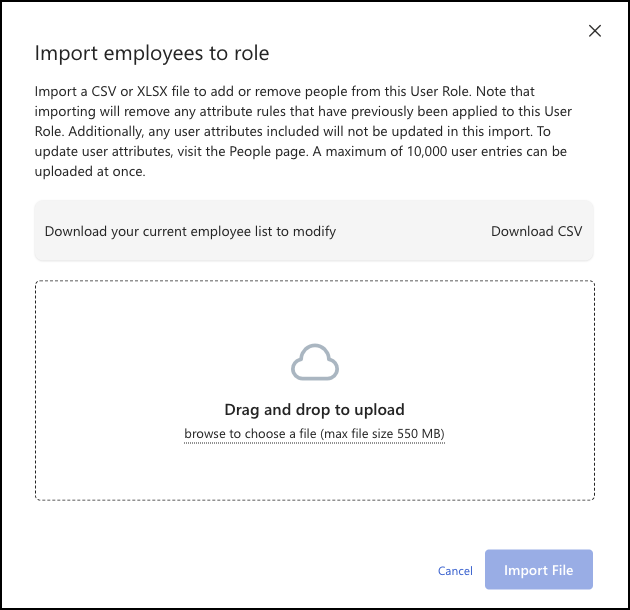
Select the Configure symbol.
In the Employees section, select User Roles. Select the User Role to update.
On the Role Settings page, select Export. In the box that opens, make your selections and select Export.
Open the downloaded .csv file and delete all columns except the column with email addresses.
Add or delete email addresses.
Note
This can be a full replacement for the existing file, so you won't need to have an Add or Remove column.
Save your file.
Return to the Role Settings page and select Import.
Select the checkbox to indicate if you only added users.
Drag and drop your file, or browse to select your file, into the area indicated.
Select Import File.
Confirm your import and select Confirm Import.
Remove a user from a User Role
- Hover over a user's name.
- Select the trash can symbol.
- Select Yes, Remove.
View and edit attribute rules for a User Role
This functionality works for roles which already have filters and/or populations applied to them.
- From the User Roles page, select a role to view or edit.
- On the Role Settings page, the number of members of this group will display and the attribute rule applied. (Example: Includes: Gender: Female)
- To change, select Edit Attribute Rules.
- In the new display window, choose from:
- I want to include all active employees only, or
- I want to filter all active employees by the following populations
- Add new populations and filters as desired.
- Choose whether to include inactive employees or to exclude any employees.
- Select Save Changes.
Grant custom access
Custom access is intended for users who need to have their default access overridden or are in a role that is so specific, it needs to be per user rather than at the User Role level. For example, use custom access for HRBPs who serve unique combinations of employee groups in your organization. To grant custom access in bulk to multiple users for survey, Focus Area, and Admin access, see: Advanced Configuration uploads.
Feedback
Coming soon: Throughout 2024 we will be phasing out GitHub Issues as the feedback mechanism for content and replacing it with a new feedback system. For more information see: https://aka.ms/ContentUserFeedback.
Submit and view feedback for